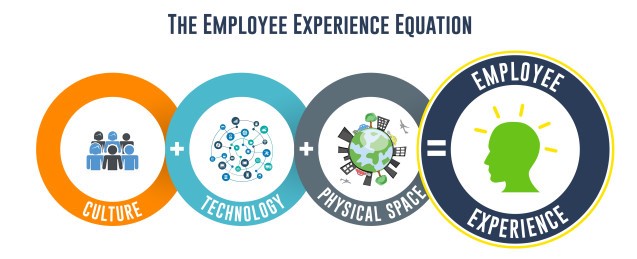Creating
a quality employee experience is a dream for every HR management. The employee
experience basically defines what the HR of an organization is really about.
●
Employee
Experience: Meaning
There
are three major things that make up employee experience at every company around
the world.
1. Technological Environment: these are the actual tools that
employees use to get their jobs done. This includes the user experience, user
interface, mobile devices, desktop computers, the apps that the employees are
using, anything related to technology that falls into the technological
environment.
Is your organization providing the tools that are beautiful, modern, relevant,
and that allows the employees to get their jobs done in a way that they feel
convenient to do? If the answer is yes, then the organization is providing a
quality employee environment in regard to technology.
2. Physical Environment: the physical environment is
everything that you see around you, whatever that you can touch, taste, smell,
and breathe in and out. For instance, the open cubicle, the art that’s hanging
on the wall or the stairs to your office, it can be anything. The physical
space is quite literally just what happens when you walk into the front door of
your organization.
This is quite crucial because employees spend most of their time inside the
organizations and the physical environment makes a big difference. How the
employees communicate, how they collaborate, how they feel if they want to be
engaged, inspired.
The physical space makes a big difference, that’s what organizations oftentimes
neglect and forget about.
3. Cultural Environment: the third and last environment is
the most famous and known. This environment determines how the employees
actually feel inside the organization. The vibes that they get, the cultural
environment includes everything from organizational structure to leadership
style to compensation and benefits. Anything that creates the kind of vibe
within the organization.
All
three factors- technological, physical, and cultural environment together make
one complete employee experience.
Organizations
have historically focused on one, or maybe two at a maximum of those three
environments. Although, the future that we are evolving into is focusing on all
three environments. The organizations that are applying all these three
environments within their companies can be called Experiential organizations.
Employee
experience is the environment where the employees really want to show up and
that’s how an environment should be created in organizations where the
employees would love to be a part of. This is what employee experience comes
down to.
The
one big assumption that organization owners always had around work is that
people need to work there, so when they assume people need to work there, they
just give them the bare minimum from the utility, the things that they need to
get their jobs done. A phone, a desk, a computer, that’s it. There is no focus
on engagement, innovation, and inspiration. None of that stuff matters in
organizations with the poor employee experience.
Now
that we live in a world where the war for talent has never become fiercer,
organizations have to shift their mentality from creating a place where they
assume people need to be there to creating a place where people naturally want
to be there.
This
shift from utility to experience, from the need to want. That is what employee
experience is all about. The three ways to create that is as explained, focus
on technology, focus on the physical space, and most importantly, focus on the
culture. Not one, not two, but all three of those environments need to be
focused on.
●
How to Create a
Better Employee Experience?
The
key to employee engagement is not found in once per year surveys. Free lunches
or flexible schedules don’t help, although the employees do like them.
Several
studies have pointed to one formula. A well-crafted employee experience leads
to better employee engagement. It’s really just that simple. Obviously,
improving employee engagement is not truly easy. Many organizations have tried
the perks’ path, offering free lunches, work from home days, bring your own
device programs and other goodies. But these perks don’t replace what employees
crave. An authentic experience rich with fulfilment and belonging is what the
employees crave.
Employee
engagement represents a real connection between the employee and the
organization. It increases productivity, higher devotion to work, less employee
turnover, and higher profitability are all the tangible results of a truly
engaged workforce or good employee engagement.
Employee
engagement doesn’t spontaneously bloom like in each organization. Organizations
need to nurture it with support, planning, and all the tools necessary to make
the initiative, a success.
Often
there’s a disconnect between how employees view work, and how employers see
work. While employees look at work and see community. Employers frequently see
the employee-employer relationship as a contract.
➢ Here’s what employees want at work
along several dimensions-
1. They want their organization to
value their contributions.
2. They want their organization to
appreciate their presence, their very being.
3. They want to experience the
connection that comes from doing good work with good people.
4. They want their organization to
value their ideas and experience.
5. Employees want to experience a sense
that their work matters.
●
Crafting a Great
Employee Experience
1. Research: find out what your employees need and want. Use focus
groups, surveys, and manage input to gather information. Taking the time to
discover and gather insights into how employees perceive their work is vital.
2. Define the Employee Experience you Wish to Create: once you have completed your
research, it’s time to put some definitions on paper. What kind of employee
experience do you want or intend to create? It’s hard work to shape these ideas
into concrete definitions. So consider these two questions as a guide. Firstly,
how do you want employees to feel about their experience at work? Secondly,
what kind of experience and culture do you need?
At this point, it’s important to get the leaders involved. First of all, they
will have ownership if they participate in the definition stage. Secondly, as
they wait into defining the employee experience, they will get to understand
their teams better. This should enhance their leadership.
3. Feedback: feedback is the next necessary step. Once you have defined
the employee experience, put the definition up for honest feedback. Your
employee experience definition might get a few bruises, and things will
definitely be tweaked.
But the beauty of good feedback is that, after the dust has settled, a
motivating and foundational employee experience definition will be born.
4. Look for gaps that need to be addressed: it’s truth time. With your fresh
definition in the head, it’s time to assess and measure against it, to create a
line and address gaps. Consider policies and practices, create cultural
reviews, and examine systems.
You want to find out how the actual experience aligns with the desired
experience and if it doesn’t work, leadership and HR can address what needs to
be adjusted. Use HR technology tools to measure the pulse of your organization
all year long, so you can learn about the needs and expectations of employees.
Use these data to adapt to the changing needs of your colleagues. Over time,
this regular feedback will clarify the employee engagement picture. It will allow
you to easily craft action plans to address the areas of need, whether it’s
learning and development, compensation or recognition.
Conclusion
Employee experience as you have read throughout this article is the essence of
any organization. It requires proper time, care, study, and resources.
Management’s most crucial job, especially HR management is to create a good
employee experience while keeping in mind all the environments- technological,
physical, and cultural. Having a good employer experience not only helps in
reducing the employee turnover in a year but also helps in creating a good
reputation of the organization in the talent market, thus, allowing the company
to get the best talents in the market available.




















